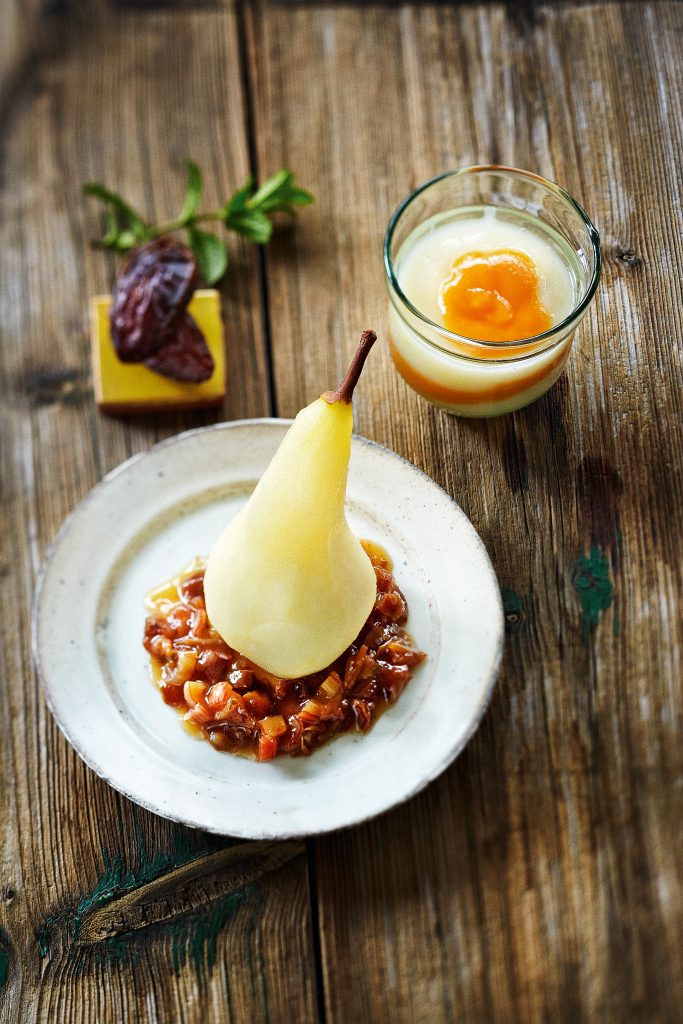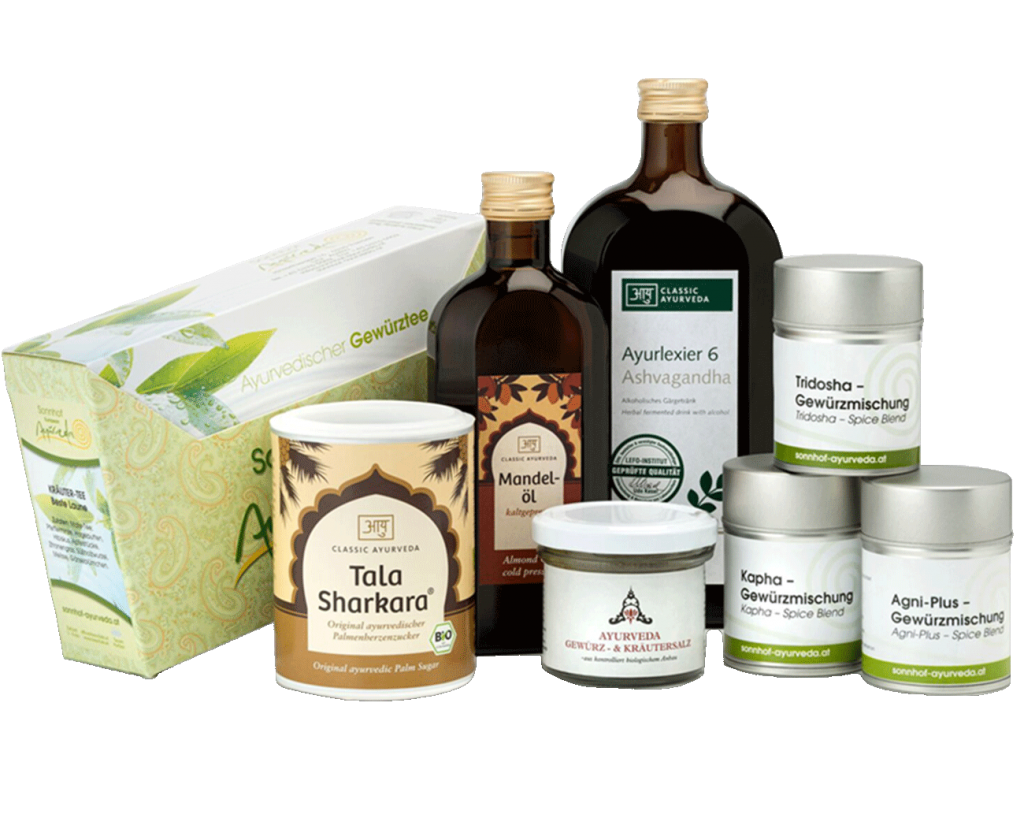Ayurveda comes from India and translated means "the knowledge" (veda) "of long life" (ayur). It is the oldest holistic healing art of mankind and not only massages, special cleansing cures and physical exercises (yoga) are part of the Ayurvedic way of life, but also nutrition. All elements together are supposed to keep the various bodily functions, such as metabolism, digestion and tissue in balance, so that no diseases can develop.
Diets can be adapted according to type. Ayurveda distinguishes here between the three doshas: Kapha, Pitta and Vata. Each person corresponds to one of these three doshas, depending on the expression of various characteristics.
Tips for the Ayurvedic diet
- In other diets, the focus is on raw food. Not so with Ayurveda. Here it is recommended that most of the food is eaten cooked. Only at lunchtime can a salad, for example, be eaten as a side dish, because at this time the digestive system has the most energy. Cooked food is easier for the body to absorb, which is why raw vegetables should be avoided in the evening.
- Eat only smaller amounts. The stomach should only be about three quarters full.
- Allow 4 to 5 hours between each main meal. The food should always be completely digested before you eat something new.
- Always use pure butter fat(ghee) for frying and cooking. Ghee is particularly valued for its many health-promoting properties.
- For seasoning, it is best to use Ayurvedic spices such as turmeric, cumin, coriander, garam masala, chilli or ginger. This not only gives your dishes a typical Ayurvedic flavour, it also makes it easier to digest the food.
- And last but not least: Enjoy your meals in a relaxed atmosphere. Don't read the newspaper, listen to the news or watch the latest episode of your favourite show. You should also not discuss difficult topics at the table. These things all interfere with the digestive process.
So that you can also cook Ayurvedic dishes at home in the future, we have picked out our favourite recipes for you.
Colourful vegetables with coriander sauce
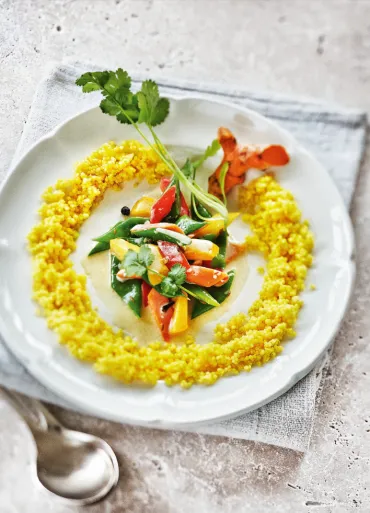
It is particularly good for all doshas to prepare the vegetables in a slightly thick sauce. During cooking, the amount of water should therefore vary.
Ingredients
- 500 g vegetables depending on the season (such as broad beans, carrots, potatoes and broccoli)
- 1 tbsp liquid ghee or refined sunflower oil
- 1 ¼ tsp cumin seeds
- ½ tsp fenugreek seeds
- 10 black peppercorns
- 4 cloves
- 1 pinch asafoetida
- ½ tsp paprika powder
- ½ tsp turmeric powder
- 1 ¼ tsp salt
- 150 ml coconut milk
- 50 ml water
- 1 handful fresh coriander leaves (chopped)
Preparation
- Wash the vegetables and peel the carrots and potatoes. Then cut everything into small pieces.
- Heat ghee or oil in a pan. Roast the cumin seeds, fenugreek seeds, black peppercorns and cloves in it until lightly golden brown (about 20 seconds).
- Add the asafoetida, toss everything briefly and then immediately add the vegetables, turmeric, paprika and salt.
- Cover and steam over a medium heat, turning regularly.
- Add the coconut milk and water and continue to simmer until the vegetables are soft.
- Finally, add fresh coriander leaves, remove from the heat and serve.
Saitan & Bean Curry with Mango Rice Milk
It is also great to cook any vegetables instead of or in addition to saitan, such as broad beans. This is good for all doshas! If you are a Pitta type, take half of the curry masala, if you are a Kapha type, you can omit the saitan and use additional vegetables such as carrots.
Ingredients
- 200 g saitan
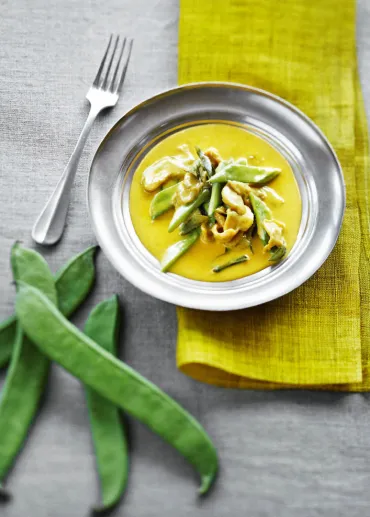
Curry Masala:
- 300 ml rice milk
- 50 ml coconut milk
- 4 tbsp mango puree
- ½ tsp salt
Mösern or paint:
- 1 tsp coriander
- ¼ tsp cumin
- ½ tsp fennel
- ½ tsp mustard
- ½ tsp fenugreek seeds
- 7 black peppercorns
- 1 small aniseed
- 5 green cardamom pods
- ¾ tsp turmeric powder
Preparation
- Chop the saitan as desired.
- Heat the oil or ghee slightly and fry the asafoetida for 3 seconds, the curry leaves for 10 seconds and the curry masala for 5 seconds.
- Immediately add rice milk, saitan, mango puree and salt.
- Let everything simmer on medium heat until the sauce is slightly thick. Then remove from the cooker.
Pear with caramel dates
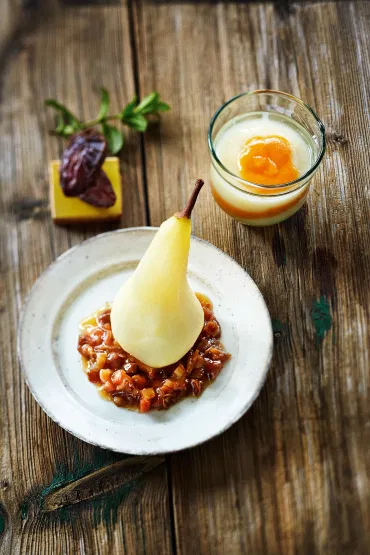
This dish is not only delicious, but also ideal for Pitta and Kapha. If you are a Kapha type, you can add 1 tbsp grated ginger along with the dates. If you are a Vata type, you should enjoy this dessert in small quantities.
Ingredients
- 4 tbsp. whole cane sugar
- 250 ml water
- 100 g dates
- ½ cinnamon stick
- 2 tsp cornflour
- 2 pears
- 500 ml water
- 50 g whole cane sugar
- 1 cinnamon stick
- 7 cloves
- 2 aniseed stars
- 1 tsp turmeric
Preparation
- Peel, halve and core the pears. Then simmer them in the water with sugar, cinnamon, cloves, aniseed and turmeric for 15 minutes.
- Take everything off the heat and let the pears cool in the syrup. If possible, leave to infuse for a few hours.
- Heat 4 tbsp sugar in a saucepan and let it caramelise until light brown.
- Then deglaze with 250 ml water, dice dates and add.
- Let everything simmer for 5 minutes. Then dissolve the cornstarch in 2 tbsp water and add while stirring vigorously. Remove from the cooker after 1 minute.
- Remove the pears from the syrup, cut them into oblong slices and serve the dessert garnished with the caramel sauce.
Spice tea to activate the metabolism
Ingredients (for 2 servings)
- 500 ml water
- ¼ tsp cinnamon
- ½ tsp black pepper
- 1 tbsp dried curry leaves
- 1 ½ tsp turmeric
- ½ tsp freshly grated ginger
Preparation
- Bring the water to the boil with the cinnamon, pepper and the curry leaves
- Then reduce the heat and let the water simmer gently for about 5 minutes. You can then turn off the heat completely.
- Then add the turmeric powder and spread the ginger over 2 cups.
- Now pour the spiced tea over the ginger and let everything steep for 8 - 10 minutes.
Tip: Drink the tea on 5 consecutive days in the morning as well as in the evening. Ideally directly before going to bed. Then take a five-day break before consuming the tea again for 5 days.
We hope you enjoy cooking the Ayurvedic recipes and wish you bon appétit! Namasté.
Tell us: What is your personal favourite Ayurvedic recipe? You will find the comment function at the bottom of the page.

